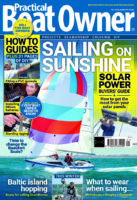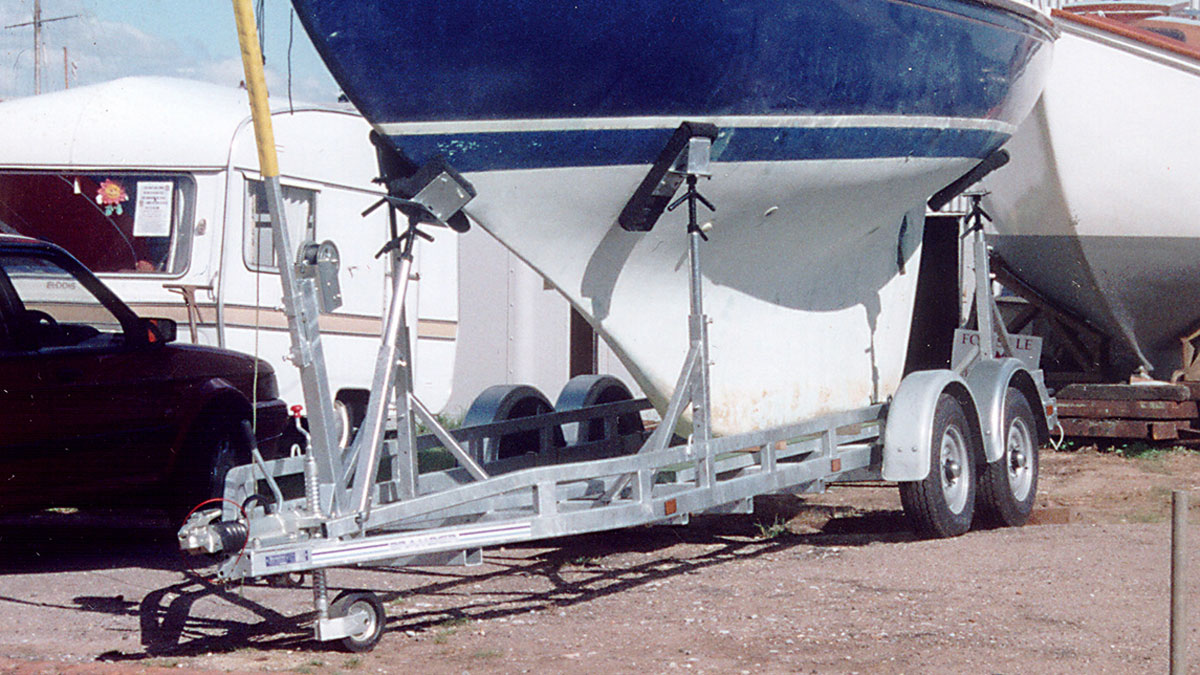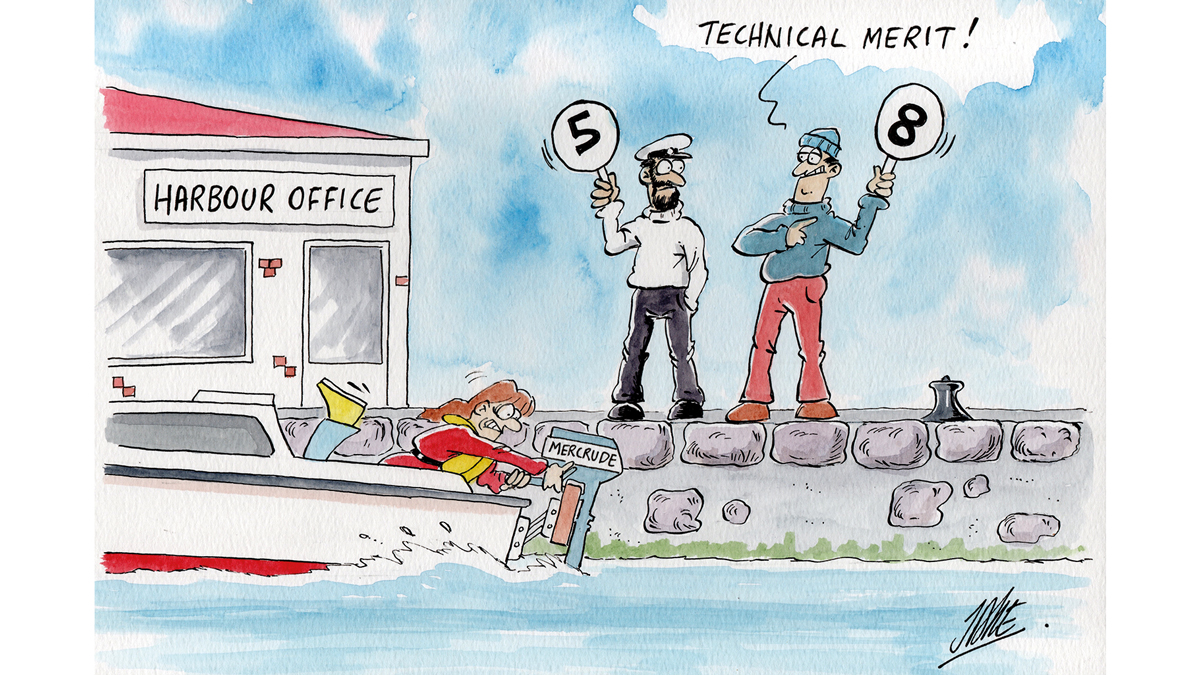Why this Dutch couple chose the Solent to start Boats on Wheels, their trailer-sailer selling business.
Hein and Hilary Kuiper were ‘big boat’ sailors before setting up their trailer-sailer dealership Boats on Wheels on the South Coast. Coming from the Netherlands, they found mooring to be ‘horrendously expensive’.
“If we wanted to sail further afield and explore new waters, we needed to undertake lengthy sea passages with bored kids opting to stay down below,” says Hein. “We decided to do something about it, so started trailer-sailing.
Now we’re real converts! We can drop a boat in the water for a day, or a few weeks, at a fraction of the cost of a mooring and we can easily explore sailing areas much further afield, getting there in no time by road.”
Long before Boats on Wheels, Hein Kuiper’s first trailer-sailer was a Sportina 680, ‘a really light, Polish-made boat’. They were on a break between yachts when they thought, why not bring over small boats from the continent, where they’re cheaper and more widely available?
“Trailer sailing is an alien concept for so many people,” says Hein. “We discovered the prime market was here in the Solent, where it costs a fortune to moor,” says Hein. “We started refurbishing trailer-sailers, and then went on to importing new boats as well.”
This import business would eventually become Boats on Wheels.

The Kuipers are passionate about trailer-sailers. Photo: Hein Kuiper.
Being Dutch, Hein is familiar with many of the great boats sailed on the Continent, and have sourced a few of their favourites for the UK market.
“Certain countries tend to have an advantage in terms of the number and types of trailer-sailers around. Poland is a prime example, with its large lakes and canals where you need to drop the mast easily. It’s uncommon in the UK, but the Poles have perfected that art. The Dutch, too, with their canals and bridges have got very good at it.
“You need leverage; how do you get something heavy and horizontal into a vertical position? You need the control when raising it because the shrouds are slack. The Poles and Dutch do that effectively, and many boats carry integrated mast-lifting gear that can do it quickly and prevent swaying.”
There are some good British builders too that make trailer-sailers; for example, Cornish Crabbers and Drascombe. Then there are contemporary models such as those by Swallow Yachts.
How Covid sales helped Boats on Wheels grow
The Covid outbreak did a lot to educate people about trailer-sailers. Unable to travel overseas or even far from their own home, people were looking for small weekend boats to escape to, and started turning to businesses like Boats on Wheels.
What the Kuipers are seeing now are two main groups of boat owners.
At the entry-level, there are those wanting to upgrade from a dinghy to their first small yacht, and even if they don’t intend to trail it, by default they’ll end up with something trailerable.
Then there are the downsizers. A smaller yacht is much simpler to sail as everything is within reach and the deck is closer to the pontoons.
“Perhaps it used to be the whole family, but the kids don’t want to sail anymore. Or sometimes, when it was originally a couple, it’s now just one of them who wants to sail single-handed,” says Hein.
“When it’s harder to find crew you need to do it all yourself; including rigging, getting the mast up, launching and sailing single-handed. The problem is, you do a lot of things when you’re younger because you physically can, but when you get older you can’t so that’s where the mast lifting kits come in. With the right system, this very complicated job can be done easily, and it’s really positive to see people able to keep sailing this way.”
In between these groups, though less common, you get those looking for a family boat. With teenagers on board, the priority is typically greater volume, ie more headroom and legroom.
“Many of the Polish boats, and some American ones, do this well,” says Hein.
“There’s always a compromise, though, because as soon as you create lots of space down below, it’s more of a lump to drag around the country and get back in and out of the water.”
For younger kids, high freeboard is an advantage.
“The Parkers have pretty good enclosed cockpits; you want a bit of coaming and a transom; the Parker 235 does that well, and also has a deep cabin.”
Sporty trimarans

The Astus is a fun and sporty trimaran that can be folded for towing. Photo: David Harding.
Some people opt for a boat that doesn’t heel. “We like to offer the trimarans in this instance because they sail so flat,” says Hein. “At Boats on Wheels, one of our customers has an Astus and swears by it. But it’s not just children who prefer this. It can be the same for older people who are not so steady on their feet.”
Plus, the benefit of a multihull is having the extra space afforded by a trampoline: “This is handy if you have teenagers – you can stick a tent on it and get rid of them!”
Performance
If faster sailing is your priority, you’ll be after a light boat. Hein recommends the British-built BTC, which is at the performance end of trailer-sailers but has four berths.
“The good thing with lighter trailer-sailers is that they’re easier to tow. Lots of people underestimate how quickly a boat that is 1.3 tonnes can become 1.6 tonnes once you have the kit on board; and then you have the trailer itself.”

The Dutch Pointer 22 has a light displacement of 750kg. Photo: Hein Kuiper.
One way that boats can be lighter is by opting for water ballast, which is taken from the body of water you’re sailing in, be that a lake or sea, via a valve. You then pump it back out when you’re done.
There is a downside, though: “There’s only so much weight in water and you can only carry it inside the hull, so it’s not as effective as having metal or lead low down in the keel,” says Hein. “You basically need to carry proportionally more water volume on board, which takes up space.”
Advice from Boats on Wheels on where to take a trailer-sailer
There are countless places to trailer sail in the UK and beyond.
The Kuipers particularly like the Fal in Cornwall, where lifting keel boats can enjoy the many shallows, as well as Chichester and Poole harbours. “These sheltered bodies of water are great for people trying out their first yacht, while also being beautiful,” says Hein. “On the East Coast, Suffolk has lovely estuaries, and some customers of ours have even towed their boats to the west coast of Scotland – I get very jealous when they send me their videos!”
Of course, the joy of trailing a boat is you can take them abroad too. Rather than spending weeks sailing to a destination, only to have to turn around, you can simply board a ferry or take the Channel tunnel.

Towing a refurbished Jeanneau Sun 2000. Photo: Jack Gore.
“We bought our demonstrator Astus from the manufacturer in France, and decided why not sail around the Morbihan in Brittany? It was beautiful, and very different to where we sail most of the time,” says Hein.
Some of the ferry crossings – particularly Dover to Calais – are quite reasonable, but the Kuipers have frequently caught the ferry from Portsmouth to St Malo or Caen. A word of warning, though, be sure to check for people trying to enter the country illegally.
“You have to watch out for people jumping on the back of the boat. It’s happened twice to us in Caen.
“They wait until you slow down; you don’t even need to stop, and then they drop on the back. While you’d notice in your car, you wouldn’t necessarily spot a person 8m behind, so make sure you lock your boat too!”
Tips for buying a used boat trailer
Tony Davies advises on what to look out for when buying a used boat trailer
How to replace boat trailer leaf springs
Steve Walburn replaces his boat trailer leaf springs
How to launch a trailer sailer (and the key mistakes to avoid)
George was helping to launch his friend’s boat and asked if Paul and I could give them a hand. My…
Best trailer sailboats: Our trailer sailing expert offers his recommendations
Paul Adamson from the Isle of Man, writes: “My wife and I are looking to buy a trailer sailboat, mainly…
Want to read more articles like this?

A subscription to Practical Boat Owner magazine costs around 40% less than the cover price.
Print and digital editions are available through Magazines Direct – where you can also find the latest deals.
PBO is packed with information to help you get the most from boat ownership – whether sail or power.
-
-
-
- Take your DIY skills to the next level with trusted advice on boat maintenance and repairs
- Impartial, in-depth gear reviews
- Practical cruising tips for making the most of your time afloat
-
-
Follow us on Facebook, Instagram, TikTok and Twitter








